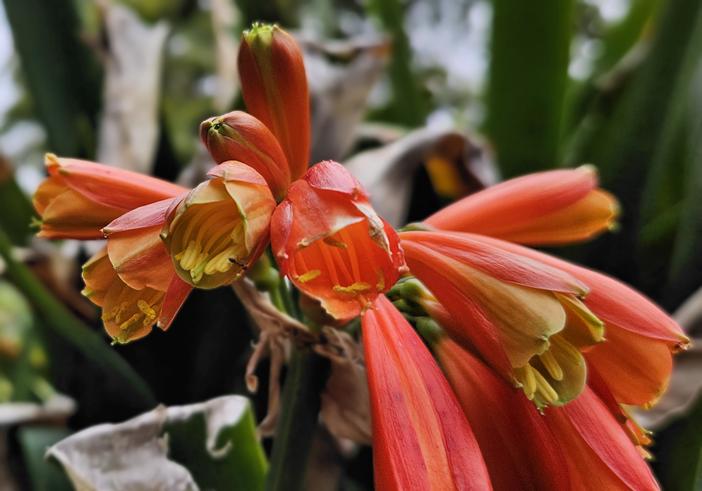Bush Lily
(Clivia caulescens)
Bush Lily (Clivia caulescens)
/
/

Eric Polk
CC BY-SA 4.0
Image By:
Eric Polk
Recorded By:
Copyright:
CC BY-SA 4.0
Copyright Notice:
Photo by: Eric Polk | License Type: CC BY-SA 4.0 | License URL: https://creativecommons.org/licenses/by-sa/4.0 | Uploader: Epolk | Publisher: Wikipedia Commons












Estimated Native Range
Summary
Clivia caulescens, commonly known as Bush Lily, is an evergreen perennial herb native to the understory of forested areas and woodland margins in Eswatini and Northern South Africa. It typically grows to a height and width of 1-2 feet (0.3-0.6 meters). The Bush Lily is characterized by its strap-shaped, dark green leaves and a clumping growth habit. Its trumpet-shaped flowers, which appear mainly in spring, are a striking orange with a yellowish-green throat, and they are arranged in a dense cluster atop a sturdy stalk. The flowers are quite showy and make the plant a popular ornamental.
The Bush Lily is valued for its ability to thrive in low light conditions, making it an excellent choice for indoor cultivation or shaded garden areas. It is often used as a container plant or as part of a shaded border. In cultivation, it requires well-drained soil, consistent moisture, and should be protected from direct sunlight to prevent leaf scorch. While it is generally easy to maintain, it is sensitive to overwatering, which can lead to root rot. Clivia caulescens is also appreciated for its drought tolerance once established. It is not typically prone to serious pests or diseases, but mealybugs and scale insects can occasionally be a problem.CC BY-SA 4.0
The Bush Lily is valued for its ability to thrive in low light conditions, making it an excellent choice for indoor cultivation or shaded garden areas. It is often used as a container plant or as part of a shaded border. In cultivation, it requires well-drained soil, consistent moisture, and should be protected from direct sunlight to prevent leaf scorch. While it is generally easy to maintain, it is sensitive to overwatering, which can lead to root rot. Clivia caulescens is also appreciated for its drought tolerance once established. It is not typically prone to serious pests or diseases, but mealybugs and scale insects can occasionally be a problem.CC BY-SA 4.0
Plant Description
- Plant Type: Bulb
- Height: 1-2 feet
- Width: 1-2 feet
- Growth Rate: Moderate
- Flower Color: Orange, Red
- Flowering Season: Summer
- Leaf Retention: Evergreen
Growth Requirements
- Sun: Part Shade
- Water: Medium
- Drainage: Medium
Common Uses
Bee Garden, Bird Garden, Butterfly Garden, Hummingbird Garden, Low Maintenance, Showy Flowers
Natural Habitat
Understory of forested areas and woodland margins in Eswatini and Northern South Africa
Other Names
Common Names: Natal Lily, Stem Clivia, Stalked Clivia
Scientific Names: , Clivia caulescens,
GBIF Accepted Name: Clivia caulescens R.A.Dyer